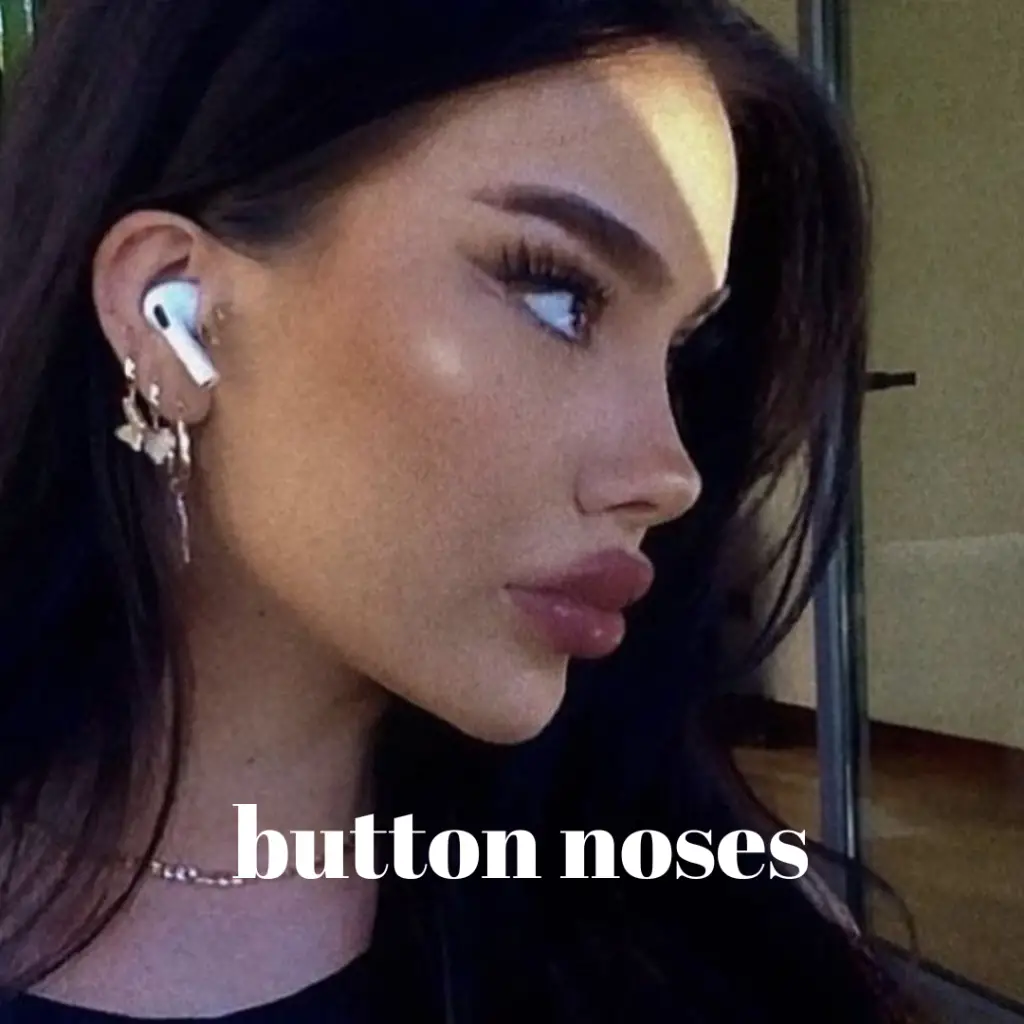A button nose is a captivating facial feature that has been a subject of fascination for ages. In this comprehensive article, we delve into the allure and science behind this enchanting attribute. From exploring its anatomy to understanding its cultural significance, genetics, psychology, and even its portrayal in popular culture, we aim to provide an in-depth analysis of the button nose phenomenon.

Understanding Facial Anatomy
The Nose: A Central Feature
If you buy something through the links on the site, I may earn an affiliate commission (at no cost to you).
The nose plays a pivotal role in defining one’s facial aesthetics. It serves both functional and aesthetic purposes, contributing to the overall balance and harmony of the face. Its position and shape can greatly influence an individual’s appearance.
Different Nose Shapes
Nose shapes vary across individuals and are influenced by factors such as genetics, ethnicity, and environmental factors. Common nose shapes include the button nose, Roman nose, Greek nose, and more. Each shape carries its own unique charm and characteristics.
Anatomy of a Button Nose
Definition and Characteristics
A button nose is typically characterized by its small, round, and slightly upturned shape. It is often associated with a cute and youthful appearance, radiating an undeniable charm. Its proportions and features make it an attractive focal point of the face.
Proportions and Features
The button nose tends to have well-balanced proportions in relation to other facial features. Its size and positioning create a harmonious balance, enhancing the overall facial symmetry. The slight upturn at the tip adds a playful and endearing touch.
Cultural Significance of Button Noses
Button Noses in Art and Media
Throughout history, button noses have been celebrated in various art forms, including paintings, sculptures, and literature. Their portrayal often symbolizes innocence, youthfulness, and beauty.
Symbolism and Perception
Button noses hold different cultural meanings and interpretations across societies. In some cultures, they are associated with positive attributes such as kindness, approachability, and cuteness. Understanding these cultural nuances helps us appreciate the diverse perspectives on beauty.
Genetics and Button Noses
Hereditary Factors
Genetics play a significant role in determining an individual’s nose shape, including the presence of a button nose. Certain genes influence the development and growth of nasal structures, leading to variations in nose shapes among family members.
Genetic Variations and Influences
Various genetic factors contribute to the button nose phenotype. Genetic research has identified specific genes associated with nose shape determination, shedding light on the intricate mechanisms behind the development of this charming facial feature.
characteristics of button nose
| Characteristic | Description |
| Size | Small and proportionate size, often slightly upturned |
| Shape | Round or bulbous shape, with a soft and gentle curvature |
| Bridge | Minimal or no visible bridge, creating a seamless transition between the forehead and nose |
| Nostrils | Small and delicate nostrils, often positioned slightly higher on the nose |
| Symmetry | Generally symmetrical in appearance, contributing to facial harmony |
| Skin | Smooth and even skin texture, with minimal pores or visible imperfections |
| Projection | Less projected than other nose shapes, with a subtle, dainty projection |
| Youthful Appearance | Often associated with a youthful and cute aesthetic |
| Approachability | Button noses can convey an approachable and friendly impression |
| Cultural Significance | Symbolizes beauty, charm, and desirability in various cultures and historical eras |
Psychology of Button Noses
Attractiveness and Perception
Button noses are often perceived as attractive due to their inherent cuteness and youthful appeal. Psychological studies have shown that facial features, including the nose, play a significant role in the perception of beauty and attractiveness.
Psychological Impact on Self-esteem
Individuals with button noses may experience positive self-perception and increased confidence due to societal ideals and cultural preferences. Embracing and celebrating diverse nose shapes can help promote self-acceptance and boost self-esteem.
Fashion and Makeup Tips for Button Noses
Enhancing the Button Nose Shape
Fashion and makeup techniques can be employed to accentuate the natural beauty of a button nose. Choosing suitable hairstyles, accessories, and specific makeup application methods can further enhance the attractiveness of this charming feature.
Makeup Techniques
Contouring, highlighting, and the strategic use of cosmetics can help create optical illusions, enhancing the shape and proportions of a button nose. Makeup artists employ various techniques to bring out the best in this captivating facial attribute.
When it comes to makeup for a button nose, the goal is to create the illusion of a longer and more defined nose. Here are a few tips to enhance a button nose:
- Contouring: Use a matte contour powder or a cool-toned bronzer to create shadows on the sides of your nose. Apply the contour shade along the sides of your nose, starting from the inner corners of your eyebrows and blending towards the nostrils. This will help create the illusion of a narrower nose.
Product Recommendation: NYX Professional Makeup Highlight & Contour Pro Palette
- Highlighting: Apply a light, shimmery highlighter down the center of your nose. This will draw attention to the middle of your nose and create the illusion of length.
Product Recommendation: Wet n Wild Megaglo Highlighting Powder
- Blending: Make sure to blend the contour and highlighter well to avoid any harsh lines. Use a small, fluffy brush or a beauty sponge for seamless blending.
Product Recommendation: Real Techniques Miracle Complexion Sponge
- Eyebrow Definition: Well-defined eyebrows can help balance and enhance the appearance of a button nose. Ensure your eyebrows are properly groomed and shaped to frame your face.
Product Recommendation: Maybelline Total Temptation Eyebrow Definer Pencil
Iconic Personalities with Button Noses
Celebrities and Their Button Noses
Many renowned personalities have embraced and showcased their button noses with pride. From iconic actors and actresses to musicians and models, their confidence and unique features have challenged traditional beauty standards, inspiring others to embrace their individuality.
Influence on Beauty Standards
The influence of celebrities with button noses has played a significant role in reshaping beauty standards. By embracing their unique facial features, these individuals have broadened the definition of beauty, promoting inclusivity and diversity in the fashion and entertainment industries.
Button Noses in Different Ethnicities
Button Noses Across Cultures
Button noses can be found across various ethnicities, each with its distinct characteristics and proportions. Exploring the prevalence and cultural significance of button noses in different ethnic groups helps us appreciate the diversity of facial features worldwide.
Ethnic Features and Nose Shapes
Nose shapes often exhibit variations among different ethnicities. While some may have a higher prevalence of button noses, it’s important to acknowledge and celebrate the beauty of all nose shapes, respecting the cultural diversity they represent.

The Science of Button Noses
Facial Proportions and Symmetry
Scientific studies have highlighted the importance of facial proportions and symmetry in determining attractiveness. The button nose’s balanced size and shape contribute to the overall facial harmony, making it an appealing feature.
Nasal Structures and Function
The intricate anatomy of the nose, including its internal structures, plays a crucial role in its functionality. Understanding the scientific aspects of nasal anatomy helps us appreciate the complexity and importance of this small yet significant facial feature.
The Evolutionary Perspective
Adaptive Advantages of Button Noses
From an evolutionary standpoint, the button nose’s features may have conferred certain advantages. While further research is required, hypotheses suggest that a smaller, upturned nose could have aided in temperature regulation, reducing heat loss and protecting against environmental factors.
The Evolution of Facial Features
The development and evolution of facial features, including the nose, have been shaped by a combination of genetic and environmental factors. Studying the evolutionary aspects of button noses provides valuable insights into the fascinating journey of human development.
Surgical Options for Button Noses
Rhinoplasty and Button Noses
For individuals seeking to alter the shape or size of their button noses, rhinoplasty offers a surgical solution. Skilled surgeons can modify nasal structures to achieve desired aesthetic outcomes, considering individual preferences and maintaining facial harmony.
Considerations and Risks
Before considering any surgical procedure, it is essential to understand the potential risks and complications associated with rhinoplasty. Thorough consultations with qualified medical professionals can provide a clearer understanding of the procedure and its potential outcomes.
Non-Surgical Alternatives for Button Noses
Non-Invasive Techniques
Non-surgical alternatives, such as dermal fillers or injectables, offer temporary enhancements for individuals looking to alter the appearance of their button noses without undergoing surgery. These techniques can provide subtle changes and are reversible.
Temporary Enhancements
Temporary enhancements allow individuals to experiment with different nose shapes and proportions, offering a non-permanent solution to explore the aesthetic possibilities of a button nose.
Maintaining a Healthy Button Nose
Proper Care and Hygiene
Maintaining a healthy button nose involves regular care and hygiene practices. Keeping the nasal passages clear, protecting the skin, and avoiding harmful environmental factors contribute to the overall well-being of the nose.
Preventing Common Issues
Certain nasal issues, such as dryness, congestion, or allergies, can affect the comfort and appearance of a button nose. Implementing preventive measures and seeking appropriate medical advice can help mitigate these common problems.
Button Nose in Babies and Children
Development and Growth
The button nose’s charming features are often prominent in babies and children. Understanding the development and growth patterns of button noses in early stages can provide insights into their eventual appearance in adulthood.
Common Characteristics
Button noses in infants and children exhibit unique characteristics, including softness, roundness, and a slight upturn. These features contribute to their adorable and endearing appeal.
Button Noses and Allergies
Allergic Rhinitis and Nose Shape
Individuals with button noses may experience specific challenges related to allergies, such as allergic rhinitis. Allergies can affect nasal passages, causing congestion, itching, and discomfort, which may impact the appearance and function of a button nose.
Coping with Allergies
Effective management of allergies through proper medical treatment and preventive measures can help individuals maintain nasal health and preserve the natural beauty of their button noses.
Button Noses in Animals
Button Noses in Pets
Button noses are not exclusive to humans; they can also be found in various animal species. Pets, such as dogs and cats, often exhibit adorable button noses, adding to their charm and appeal.
Unique Animal Features
Animal noses serve essential functions beyond aesthetics. The distinct features and shapes of button noses in animals reflect their adaptations to their environments and play a role in their sensory capabilities.
Historical Perspectives on Button Noses
Button Noses in History
Throughout history, button noses have been portrayed and celebrated in different cultures and eras. Historical artworks, literature, and cultural references provide glimpses into the enduring fascination with this captivating facial feature.
Cultural and Historical Significance
Button noses have held cultural and historical significance, symbolizing various ideals and concepts. Exploring these perspectives deepens our understanding of the enduring allure of button noses in human history.
The Fascination of Button Noses in Pop Culture
Memes, Trends, and Button Noses
In the era of social media and internet culture, button noses have gained further popularity through memes, trends, and viral sensations. The online community’s fascination with button noses highlights their universal appeal and enduring charm.
Viral Internet Sensations
Certain individuals with prominent button noses have become internet sensations, captivating audiences and spreading joy through their unique features. These viral moments demonstrate the power of individuality and the celebration of diverse beauty in the digital age.
Summary and Conclusion
The button nose phenomenon encompasses a multitude of aspects, from its anatomy and genetics to cultural significance and psychological impact. This comprehensive exploration aims to shed light on the enchanting appeal and enduring charm of this facial feature.
Embracing diversity and individuality is vital in appreciating the beauty of button noses and celebrating the unique qualities that make each person’s appearance truly captivating. By understanding the science and cultural influences behind button noses, we can foster inclusivity, acceptance, and self-confidence.
FAQs
- What is the scientific term for a button nose? The scientific term for a button nose is a “nasal tip that is small, round, and slightly upturned.”
- Can the shape of a button nose change over time? While the basic structure of a button nose remains relatively stable, minor changes in shape and appearance can occur due to factors such as aging, environmental influences, and lifestyle choices.
- Are button noses more common in certain ethnicities? Button noses can be found across various ethnicities, and their prevalence may vary depending on genetic and environmental factors.
- How does the size of a button nose affect its appearance? The small and proportionate size of a button nose contributes to its appealing appearance, often evoking a sense of cuteness and youthfulness.
- Can makeup be used to create the illusion of a button nose? Yes, makeup techniques such as contouring and highlighting can be employed to enhance the appearance of a button nose and create the illusion of desired proportions.
- What are some famous personalities known for their button noses? Famous personalities known for their button noses include actors like Emma Watson and Zooey Deschanel, as well as models like Cindy Crawford and Natalie Portman.
- Is rhinoplasty the only option to alter the shape of a button nose? No, there are non-surgical alternatives such as dermal fillers or injectables that can provide temporary enhancements to the appearance of a button nose.
- Are there any health issues associated specifically with button noses? Button noses do not inherently have specific health issues associated with them. However, individuals with button noses, like anyone else, can experience common nasal issues such as allergies or congestion.
- Do animals have button noses? Yes, animals such as dogs, cats, and certain breeds exhibit button noses, adding to their adorable and appealing features.
- Why are button noses so appealing? Button noses are often considered appealing due to their cute and youthful appearance, balanced proportions, and cultural associations with positive attributes such as approachability and kindness.
Recommended for you:
Beauty comes in all shapes and sizes, and one fea...
Almond-shaped eyes are a beautiful and unique fea...
The bulbous nose is a common concern among indivi...
The aquiline nose, also known as the Roman nose, ...
Having healthy, pink lips can enhance the appeara...
Are you looking to improve your appearance and bo...

